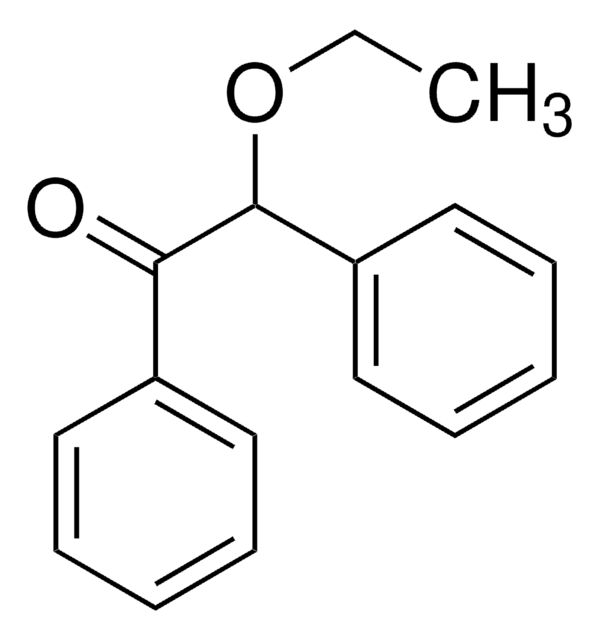If this product has an expiration or retest date, it will be shown on the Certificate of Analysis (COA, CofA). If there is no retest or expiration date listed on the product's COA, we do not have suitable stability data to determine a shelf life. For these products, the only date on the COA will be the release date; a retest, expiration, or use-by-date will not be displayed.
For all products, we recommend handling per defined conditions as printed in our product literature and website product descriptions. We recommend that products should be routinely inspected by customers to ensure they perform as expected.
For products without retest or expiration dates, our standard warranty of 1 year from the date of shipment is applicable.
For more information, please refer to the Product Dating Information document: https://www.sigmaaldrich.com/deepweb/assets/sigmaaldrich/marketing/global/documents/449/386/product-dating-information-mk.pdf
196118
2,2-Dimethoxy-2-phenylacetophenone
99%
Synonym(s):
α,α-Dimethoxy-α-phenylacetophenone, Benzil α,α-dimethyl acetal
Select a Size
Select a Size
About This Item
Recommended Products
Quality Level
Assay
99%
mp
67-70 °C (lit.)
SMILES string
COC(OC)(C(=O)c1ccccc1)c2ccccc2
InChI
1S/C16H16O3/c1-18-16(19-2,14-11-7-4-8-12-14)15(17)13-9-5-3-6-10-13/h3-12H,1-2H3
InChI key
KWVGIHKZDCUPEU-UHFFFAOYSA-N
Gene Information
human ... ACHE(43) , BCHE(590) , CES1(1066)
Looking for similar products? Visit Product Comparison Guide
Related Categories
Application
- For the photopolymerization of methacrylate monomers in thick sections(~2mm).
- In the preparation of UV-curing silicone rubber with excellent mechanical properties and thermal stability via thiol-ene reaction.
Signal Word
Warning
Hazard Statements
Precautionary Statements
Hazard Classifications
Acute Tox. 4 Oral - Aquatic Chronic 3 - STOT RE 2
Target Organs
oral cavity
Storage Class Code
11 - Combustible Solids
WGK
WGK 2
Flash Point(F)
Not applicable
Flash Point(C)
Not applicable
Personal Protective Equipment
Choose from one of the most recent versions:
Already Own This Product?
Find documentation for the products that you have recently purchased in the Document Library.
Customers Also Viewed
Articles
With dentists placing nearly 100 million dental fillings into patients′ teeth annually in the U.S. alone, polymeric composite restoratives account for a very large share of the biomaterials market.
-
How can I determine the shelf life / expiration / retest date of this product?
1 answer-
Helpful?
-
-
How is shipping temperature determined? And how is it related to the product storage temperature?
1 answer-
Products may be shipped at a different temperature than the recommended long-term storage temperature. If the product quality is sensitive to short-term exposure to conditions other than the recommended long-term storage, it will be shipped on wet or dry-ice. If the product quality is NOT affected by short-term exposure to conditions other than the recommended long-term storage, it will be shipped at ambient temperature. As shipping routes are configured for minimum transit times, shipping at ambient temperature helps control shipping costs for our customers. For more information, please refer to the Storage and Transport Conditions document: https://www.sigmaaldrich.com/deepweb/assets/sigmaaldrich/marketing/global/documents/316/622/storage-transport-conditions-mk.pdf
Helpful?
-
-
What is the density of 196118-50G, specifically 2,2-DIMETHOXY-2-PHENYLACETOPHENONE, 99%?
1 answer-
The density of 2,2-DIMETHOXY-2-PHENYLACETOPHENONE, 99% (196118-50G) is 1.1320 g/cm³.
Helpful?
-
-
What UV wavelength, amps, power, frequency, etc can I use with this?
1 answer-
The UV wavelength, amps, power, and frequency are unrecorded for this product.
For photoinitiation to proceed efficiently, the absorption bands of the photoinitiator must overlap with the emission
spectrum of the source and there must be minimal competing absorption by the components of the formulation
at the wavelengths corresponding to photoinitiator excitation. The following research article describes an application using this product in the photopolymerization of methacrylate monomers in thick sections which may be helpful.
https://www.researchgate.net/publication/264681050_Efficiency_of_22-Dimethoxy-2-phenylacetophenone_for_the_Photopolymerization_of_Methacrylate_Monomers_in_Thick_Sections"Helpful?
-
Active Filters
Our team of scientists has experience in all areas of research including Life Science, Material Science, Chemical Synthesis, Chromatography, Analytical and many others.
Contact Technical Service














